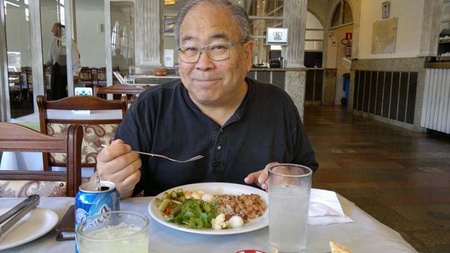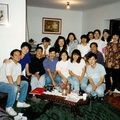A large part of cross-cultural adaptation involves something as basic as food. And depending on the culture, food can require a giant leap of adjustment. Admittedly, Brazil doesn’t have really strange food like some other cultures. There are no one thousand year old eggs filled with fertilized chicken embryos, no Indiana Jones-style monkeys’ brains, no intentional efforts to eat insects of any kind. But there were a few moments when my teams or I called into question the rule: “eat everything put in front of you.”
On her first trip to Brazil, one of our trainers and team leaders related the experience of eating sashimi. The host family had made a special effort for her. A large platter gleamed with pink sashimi on a bed of lettuce. Just like you’d get in Little Tokyo or in San Francisco’s Japantown. They heaped the sliced fish on her plate and I’m sure that her expectation was really high for a great meal!
Then came the first bite. Crunch. Crunch. Crunch. Okay, the only time I’ve had sashimi that crunched was when it was lightly frozen. Frozen is okay, after all, she was four hundred miles from the Brazilian coastline. But the crunch was not from any ice formed in the fish, it was from…well, it’s debatable!!
For many Nikkei living in the inland areas of Brazil, sashimi means river fish. Not ahi, not maguro, not hamachi, but some non-descript freshwater fish. A fish with either really firm flesh or filled with small bones, while edible, would be a surprise for anyone used to sashimi from California or Hawai`i. I didn’t get the whole story, but being trained with the “eat what’s in front of you” rule, she probably ate the whole serving.
When she told me this story, I laughed and laughed. Someone has said that humor is someone else’s sorrow. I don’t think that’s true, but it was funny up until the day it happened to me.
I was at a leadership conference in Camp Panorama. Yes, it was the place where I went fishing and caught a piranha. It was seven years later. It was lunchtime and we went up to the serving table to pick up our plates and our servings. On the table was a huge platter of pink slices of sashimi on a bed of lettuce (sound familiar?). With my chopsticks I scooped up about ten slices, thinking about how great it was to get sashimi on this trip.
Did I think about the fact that I was ten hours inland by bus from São Paulo? (São Paulo itself is at least ninety minutes from the coast.) Did I think about my colleague’s experience? Nope. There it was—soooo tempting. I took it to my seat with eager anticipation. My first bite: Crunch. Crunch. Crunch. Omigosh!!! I could hear her telling me the story and here I was living out the reality.
So now, I have a plate with nine slices of sashimi that I am not at all compelled to eat. In fact, I noticed one of the other leaders walking around the cafeteria trying to pawn off his sashimi to any takers. I ate the other food on my plate, a green salad. I quietly took my plate load of sashimi to the garbage can and unobtrusively tossed it. The rule here is not to laugh at anyone else’s misery. But there is a second rule that needs to be observed as well: follow your instinct.
On my first visit to the Panorama campground (it was the same time as described in my first story with Discover Nikkei about fishing from a dugout canoe), I picked up a dessert after one of the meals. It was a sliced fruit I had never seen before. It had a faint—no, not faint, strong—odor of banana. But it wasn’t a banana. I can’t describe it. It looked like a large, pale, yellow slug. This should be the instinct—don’t eat anything that looks like a pale, yellow slug. I tasted it and immediately knew that I didn’t want to swallow it, no less finish it. It never went past my tongue. I asked what it was and was told it was “jaca” (or jackfruit). Never heard of it.
Fast forward one year to São José dos Campos. After a Sunday evening meeting at the church, refreshments were served. The nice ladies of the church brought a plate of fruit to me and I RECOGNIZED it. Jaca. I told them, “I’ve tried this before and I didn’t like it.” They said, “Oh no, but you’ve NEVER tried jaca from this part of the state. Whatever you ate before will not compare to this delicious special fruit from our region.”
When does one’s instinct kick in? Not wanting to insult their region, and like a moth to a flame, I said, okay and I put the slice into my mouth. I chewed it a couple of times and tried swallowing it.
Now jaca is a very viscous fruit. Is that the right word? I mean slimy. But I probably also mean “vicious.” It was slimy AND sticky. Which means that in the process of trying to swallow the slice—that was probably too large anyway—got stuck in my throat. It didn’t go down because I really didn’t like it. But it wouldn’t come back up because of the consistency. It stuck. And I started to panic because I couldn’t breathe!
At this point everyone is laughing at me because they think that I just don’t like it and that’s why my face looks contorted. But it really was lodged in a bad place for me to be able to breathe. Fortunately, I coughed it up (which is a nice way to say that I hocked it up). And surrounded by about six people, ditched it into my napkin.
Follow your instincts. Isn’t that what I said? When faced with the challenge of odd food, that’s my new rule. Forget the “eat whatever is in front of you” rule. The rule now is “don’t let the food kill you!” And if it’s jaca, stay away from this vicious assassin fruit!
With special thanks and remembrance for Kazumi-san for your warm hospitality.
© 2014 John Katagi









